Inalienable possession
| Linguistics |
|---|
| Theoretical |
| Descriptive |
| Applied and experimental |
| Related articles |
| Linguistics portal |
In linguistics, inalienable possession (abbreviated INAL) is a type of possession in which a noun is obligatorily possessed by its possessor. Nouns or nominal affixes in an inalienable possession relationship cannot exist independently or be "alienated" from their possessor.[1] For example, a hand implies "(someone's) hand", even if it is severed from the whole body. Likewise, a father implies "(someone's) father". Inalienable nouns include body parts (e.g. leg, which is necessarily "someone's leg"), kinship terms (e.g. mother), and part-whole relations (e.g. top).[2] Many languages reflect this distinction, but they vary in the way they mark inalienable possession.[3] Cross-linguistically, inalienability correlates with many morphological, syntactic, and semantic properties.
In general, the alienable–inalienable distinction is an example of a binary possessive class system, i.e., a language in which two kinds of possession are distinguished (alienable and inalienable). The alienability distinction is the most common kind of binary possessive class system, but it is not the only one.[3] Some languages have more than two possessive classes: the Anêm language of Papua New Guinea, for example, has at least 20.[3]
Statistically, 15–20% of the world's languages have obligatory possession.[4]
Comparison to alienable possession
The following real-world relationships often fall under inalienable possession:[2]
| Type of relationship | Examples |
|---|---|
| kinship | father, mother, aunt |
| social relationship | trading partner, neighbor |
| body parts | eye, leg |
| part-whole relationship | tabletop, side |
| possessed noun originates from the possessor | sweat, voice |
| mental states and processes | fear, mind |
| attributes of a known possessor | name, age |
Other things, such as most objects, may or may not be possessed. When these types of objects are possessed, the possession is alienable. Alienable possession is generally used for tangible items which one might cease to own at some point (e.g. my money) whereas inalienable possession refers to a perpetual relationship which cannot be readily severed (e.g. my mother).[2]
Variation between languages
Although the relationships listed above are likely to be instances of inalienable possession, ultimately what is classified as inalienable depends on language- and culture-specific conventions.[5] It is impossible to say that a particular relationship is an example of inalienable possession without specifying the languages for which this holds true. For example, neighbor may be an inalienable noun in one language, but alienable in another.[5] Thus, whether a certain type of relationship is described as alienable or inalienable can be arbitrary, and in this respect alienability is similar to other types of noun classes, such as grammatical gender.[6]
The examples below illustrate that the same phrase, the table's legs, is regarded as inalienable possession in Italian but not in French:[7] (1b) is ungrammatical (as indicated by the asterisk); French cannot use the inalienable possession construction for a relationship which is alienable.
Italian - Inalienable possession relationship
(1a) Al tavolo, qualcuno gli ha segato tutte le gambe
to.the table someone it.DAT has sawn all the legs
‘The table, someone has sawn off all its legs'
French - Alienable possession relationship
(1b) *La table, quelqu'un lui a scié toutes les pattes
the table, someone it.DAT has sawn all the legs
‘The table, someone has sawn off all its legs'
(Cinque & Krapova 2008: 68 (ia, ib)[lower-alpha 1]) |
Bernd Heine argues that linguistic change is responsible for this language-specific variability in categorization. This is because "rather than being a semantically defined category, inalienability is more likely to constitute a morphosyntactic or morphophonological entity, one that owes its existence to the fact that certain nouns happened to be left out when a new pattern for marking attributive possession arose."[8] Under this view, nouns that are "ignored" by a new marking pattern come to form a separate noun class.
Morphosyntactic strategies for marking the distinction
The distinction between alienable and inalienable possession is often marked with various morphosyntactic properties such as morphological markers and word order. There is a strong typological pattern for inalienable possession to require fewer morphological markers than alienable possession constructions.[9]
Inalienable possession constructions involve two nouns or nominals: the possessor and the possessee. Together, they form a unit called a determiner phrase (DP). Within this DP, the possessor nominal may occur either before the possessee (prenominal) or after its possessee (postnominal), depending on the language.[10] French, for example, can use a postnominal possessor (i.e. the possessor (of) Jean occurs after the possessee the arm):
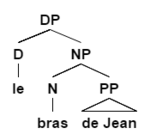
(2) le bras de Jean
the arm of Jean
'John's arm'
(Guéron 2007: 590 (la)) |
By contrast, English generally uses a prenominal possessor (e.g. John's brother). However, in select situations it may also use a postnominal possessor, as in the brother of John.[3]
Morphological markers
No overt possessive markers
The South American language Dâw uses a special possessive morpheme (bolded in the examples below) to indicate alienable possession:[11]
Alienable
(3) tɔp Tũk-ɛ̃̀ɟ
house Tũk-POSS
‘Tũk's house'
(4) tih-ɛ̃̀ɟ cɤ̀g
3SG-POSS arrow
‘his arrow'
(Martins 2004: 546) |
The possessive morpheme ɛ̃̀ɟ in examples (3) and (4) indicates an alienable relationship between possessor and possessee.
Inalienable
(5) tih nũh
3SG head
‘his head'
(Martins 2004: 547) |
This possessive marker does not occur in inalienable possession constructions. Thus, the absence of ɛ̃̀ɟ, as in example (5), indicates that the relationship between the possessor and possessee is one of inalienable possession.
Identical possessor deletion
Igbo, a West African language, deletes the possessor when the sentence's subject and the possessor of an inalienable noun refer to the same entity.[12]:87 In (6a), both the referents are the same; however, it is ungrammatical to keep both of them in a sentence. Igbo employs the processes of identical possessor deletion, and the yá (his), is dropped, as in the grammatical (6b).
(6a) *Ó sàra áka yá
Hei washed hands hisi (own)
'Hei washed hisi hands'
(6b) Ó sàra áka
He washed hands
'Hei washed hisi hands'
(Hyman et al. 1970: 87 (11, 12)) |
Word order
Possessor switch
The distinction between alienable and inalienable possession constructions may be marked with a difference in word order. Igbo uses another syntactic process when the subject and the possessor refer to different entities.[12]:89 In possessor switch, the possessor of the inalienable noun is placed as close as possible to the verb.[12] In the following examples, the possessor yá is not deleted because the two referents in this sentence are different.
(7a) *Ó hùru áka
He saw hand
'Hei saw hisj hand'
(7b) Ó hùru áka yá
He saw hand his (own)
'Hei saw hisi hand'
(Hyman et al. 1970: 87 (27, 28)) |
In the ungrammatical (8a), the verb wàra (to split), follows the possessor m. Due to possessor switch, the verb must be placed closer to the possessor. The grammatical (8b) does this by having wàra switch with the possessor.
(8a) *ísi m wàra
Head my split
'I have a headache'
(8b) ísi wàra m
Head split to me
'I have a headache'
(Hyman et al. 1970: 87 (44, 45)) |
Genitive-noun ordering
Maybrat, a language from New Guinea, varies the order of the genitive and the noun between alienable and inalienable constructions:[13][14]
In (9), the genitive Sely precedes the possessee me, marking inalienable possession.
Inalienable: Gen-N
(9) Sely m-me
Sely 3SG.F.POSS-mother
‘Sely's mother'
(Dol 1999: 93) |
However, the genitive follows the possessee in alienable possession constructions, such as (10). In this sentence, the genitive Petrus follows the possessee amah.
Alienable: N-Gen
(10) amah ro-Petrus
house GEN-Petrus
‘Petrus' house'
(Dol 1999: 97) |
Explicit possessors
Another way languages distinguish between alienable and inalienable possession is to have one noun class that cannot appear without an explicit possessor.[15] For example, Ojibwe, an Algonquian language, has a class of nouns that must have explicit possessors.[16][17][lower-alpha 2]
If explicit possessors are absent (as in (11b) and (12b)), the phrase is ungrammatical. In (11), the possessor ni is necessary for the inalienable noun nik (arm). In (12), the same phenomenon is found with the inalienable noun ookmis (grandmother), which needs the possessor morpheme n to be grammatical.
Inalienable
(11a) ni nik
POSS arm
'my arm'
Alienable
(11b) *nik
arm
'(an) arm'
(Nichols & Nyholm 1995: 138) |
Inalienable
(12a) nookmis
POSS-grandmother
'my grandmother'
Alienable
(12b) *ookmis
grandmother
'(a) grandmother'
(Nichols & Nyholm 1995: 189) |
Prepositions
Hawaiian uses different prepositions to mark possession depending on alienability. a (alienable of) is used to indicate alienable possession, as in (13a) and (14a), whereas o (inalienable of) indicates inalienable possession.[18]
Alienable
(13a) nā iwi a Pua
the bones of Pua
'Pua's bones' [as in the chicken bones she is eating]
Inalienable
(13b) nā iwi o Pua
the bones of Pua
'Pua's [own] bones'
(Elbert & Pukui 1979: 139) |
However, the distinction between a (alienable of) and o (inalienable of) is used for other semantic distinctions less clearly attributable to common alienability relationships except in metaphorical ways. Although lei is a tangible object, in Hawaiian this noun can be either alienable (15a) or inalienable (15b) depending on the context.
Alienable
(14a) ke kanaka a ke ali‘i
the man of the king
'the subject [controlled or appointed by] the chief'
Inalienable
(14b) ke kanaka o ke ali‘i
the man of the king
'the [hereditary] subject of the chief'
(Elbert & Pukui 1979: 139) |
Alienable
(15a) ka lei a Pua
the lei of Pua
'Pua's lei [to sell]'
Inalienable
(15b) ka lei o Pua
the lei of Pua
'Pua's lei [to wear]'
(Elbert & Pukui 1979: 139) |
Definite articles
More subtle cases of syntactic patterns sensitive to alienability are found in many languages. For example, French can use a definite article rather than the possessive (ses) with body parts.[19]
(16) Il lève les mains.
he raises the hands
'He raises his hands.'
(Nakamoto 2010: 75 (2a)) |
Using the definite article with body parts, as in the example above, it creates ambiguity. This sentence has both an alienable and an inalienable interpretation:
a) he raises his own hands [inalienable] b) he raises another pair of hands [alienable] |
This type of ambiguity also occurs in English with body part constructions.[20]
Spanish also uses a definite article (las) to indicate inalienable possession for body part constructions.[21]
(17) él se lava las manos
he himself washes the hands
'He washes his hands'
(Kockelman 2009: 30) |
German uses a definite article (die) for the inalienable body part construction, but a possessive (meine) for alienable possession.[21]
Inalienable
(18) Er wäscht sich die Hände.
he washes REFLEX the hands
'He is washing his hands'
(Kockelman 2009: 29) |
Alienable
(19) ich zerriß meine Hose
I tore my pants
'I tore my pants'
(Kockelman 2009: 30) |
No distinction in the grammar
Although English has alienable and inalienable nouns (e.g. Mary's brother [inalienable] vs. Mary's squirrel [alienable]), there are few formal distinctions of this in the grammar.[22] One subtle grammatical distinction is the postnominal genitive construction, which is only used with inalienable, relational nouns. For example, the brother of Mary [inalienable] is acceptable, but *the squirrel of Mary [alienable] is not normally acceptable.[22]
Since the alienability distinction is rooted in semantics, in languages like English where there are few morphological or syntactic distinctions sensitive to alienability, ambiguities occur. For example, the phrase she has her father's eyes has two different meanings:
a) her eyes resemble her father's [inalienable possession] |
Another example of this semantic dependency is the difference between possible interpretations in a language that marks inalienable possession (e.g. French) with a language that does not (e.g. English). Inalienable possession is semantically dependent and is defined in reference to another object to which it belongs.[20] (20) is ambiguous and has two possible meanings. In the inalienable possessive interpretation, la main belongs to the subject, les enfants. The second interpretation is that la main is an alienable object that does not belong to the subject. The English equivalent of this sentence (The children raised the hand) only has the alienable possessive reading in which the hand does not belong to the children.
(20) Les enfants ont levé la main
The children have raised the hand
'The children raised the hand'
(Vergnaud and Zubizarreta 1992: 596 (1)) |
Syntactically, Noam Chomsky proposed that some genitives or possessive cases originate as part of the determiner in the underlying structure.[23]:680 The inalienable possessives are derived from a different deep structure than that of alienable possession. For example, given the following interpretations of the phrase John's arm:
a) an arm that is part of John's body [inalienable] b) the arm that John happens to have physical possession of [alienable] |
In the inalienable reading, arm is a complement of the determiner phrase. This contrasts to the alienable reading where John has an arm is part of the determiner.[23]:690 Fillmore and Chomsky make a syntactic distinction between alienable and inalienable possession and suggest that this distinction is relevant to English.[23]
In contrast, others have argued that although semantics does play a role in inalienable possession, it is not central to the syntactic class of case-derived possessives. For example, compare the difference between the book's contents and the book's jacket. While a book cannot be divorced from its contents, it can be removed from its jacket.[23]:690 Regardless, both phrases have the same syntactic structure. Another example is Mary's mother versus Mary's friend. The mother will always be Mary's mother, but an individual might not always be Mary's friend. Again, both have the same syntactic structure.
The distinction between alienable and inalienable possessions can be influenced by cognitive factors.[2] Languages, such as English, that do not encode the alienability distinction in their grammar rely on the real-world relationship between the possessed noun and possessor noun. Nouns that are “inherently relational” and whose possession is associated with a single, dominant interpretation (e.g. mother), are of the inalienable type, whereas nouns whose possession is open to interpretation (e.g. car), are of the alienable type.[2]
Cross-linguistic properties
Although there are different methods of marking inalienability, inalienable possession constructions usually involve the following features:[5]
a. the distinction is confined to attributive possession b. alienable possession requires more phonological or morphological features than inalienable possession c. inalienable possession involves a tighter structural bond between the possessor and possessee d. possessive markers on inalienable nouns are etymologically older[lower-alpha 3] e. inalienable nouns include kinship terms and/or body parts f. inalienable nouns are a closed-class category, while alienable nouns form an open-class category (Heine 1997: 85-86 (1-6)) |
Restricted to attributive possession
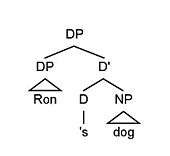
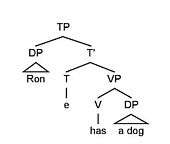
Alienability can only be expressed in attributive possession constructions, not in predicative possession.[5] Attributive possession is a type of possession in which the possessor and possessee form a phrase. This contrasts to predicative possession constructions, in which the possessor and possessee are part of a clause and the verb affirms the possessive relationship.[25] The examples in (21) express the same alienable relationship between possessor and possessee, but illustrate the difference between attributive and predicative possession.
Attributive possession (21a) Ron's dog Predicative possession (21b) Ron has a dog (21c) The dog is Ron's (Heine 1997: 87 (2)) |
Requires fewer morphological features
If a language has separate alienable and inalienable possession constructions, and if one of these constructions is overtly marked whereas the other is "zero-marked", the marked form tends to be alienable possession. Inalienable possession will be indicated by the absence of this overt marker.[26] The data from Dâw are an example of this.
One typological study discovered that in 78% of South American languages that do distinguish between inalienable and alienable possession, inalienable possession was associated with fewer morphological markers than its alienable counterpart; by contrast, only one of the surveyed languages required more morphological features to mark inalienable possession than alienable possession.[9] If a language makes a grammatical distinction between alienable and inalienable nouns, it is redundant to have an overt possessive marker to mark inalienability; by nature of being inalienable, a noun must be possessed.
Tighter structural bond between possessor and possessee
In inalienable possession constructions, the relationship between the possessor and possesee is stronger than in alienable possession constructions. Johanna Nichols characterizes this through the tendency of inalienable possession to be head-marked but alienable possession to be dependent-marked.[24] In head-marking, the head of an inalienable possession construction (the possessed noun) is marked, whereas in dependent-marking, the dependent (the possessor noun) is marked.[27]
Theories of representation in syntax
Since the possessor is crucially linked to an inalienable noun's meaning, inalienable nouns are assumed to take their possessors as a semantic argument.[28] Possessors (whether to alienable or inalienable nouns) can be expressed with different constructions. Possessors in the genitive case (such as the friend of Mary) appear as complements to the possessed noun, as part of the phrase headed by the inalienable noun.[20] This is an example of internal possession because the possessor of the noun is inside of the determiner phrase.
External possession
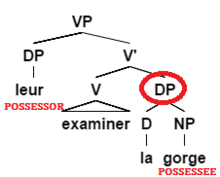
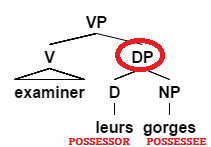
Inalienable possession can also be marked with external possession. These are constructions in which the possessor appears outside of the determiner phrase. For example, the possessor may appear as a dative complement of the verb. French exhibits both external possessor construction and internal possessor construction, as in (22):[20]
External possession:
(22a) Le médecin leur a examiné la gorge.
the doctor to them examined SG DEF DET throat
'The doctor examined their throats.'
Internal possession:
(22b) Le médecin a examiné leurs gorges.
the doctor examined POSS(3PL) throat
'The doctor examined their throats.'
(Vergnaud and Zubizarreta 1992: 596 (4b, 6b)) |
However, these type of possessors are problematic. There is a discrepancy between where the possessor appears syntactically in an inalienable possession construction and what its semantic relationship to the inalienable noun seems to be. Semantically, the possessor of an inalienable noun is intrinsic to its meaning and acts like a semantic argument. In the surface syntactic structure, however, the possessor appears in a position that marks it as an argument of the verb.[10] Thus, there are different views on how these types of inalienable possession constructions should be represented in the syntactic structure. The binding hypothesis argues that the possessor is an argument of the verb. Conversely, the possessor-raising hypothesis argues that the possessor originates as an argument of the possessed noun and then moves to a position where on the surface it looks like it is an argument of the verb.[29]
Binding hypothesis (Guéron 1983)
The binding hypothesis reconciles the fact that the possessor appears both as a syntactic and semantic argument of the verb but as a semantic argument of the possessed noun, by assuming inalienable possession constructions are subject to the following syntactic constraints:[10]
a. There must be an obligatory possessor. b. The possessor must be in the same minimal domain of the possessee. c. The possessor must c-command the possessee or its trace (i.e. c-command must occur in the underlying or surface structures of the inalienable possession constructions. |
It is assumed that inalienable possession constructions are one form of anaphoric binding: obligatory control.[28] Thus, the possessor DP originates in the specifier of the verb; the fact that the possessor seems to be a semantic argument of the noun arises from the binding relationship between the possessor and possessee DPs. The parallel between inalienable possession constructions and obligatory control can be seen in the examples below:[19]
Inalienable possession
(23a) Jeani lève lai main
Jean raise the hand
'Jean raises his hand.'
Obligatory control
(23b) Jeani veut PROi partir
Jean want (Jean) to leave
'Jean wants to leave'
(Nakamoto 2010: 80 (30a,b)) |
This hypothesis accounts for differences between French and English, and it may also eliminate the ambiguity created by definite determiners.[28] According to this hypothesis, anaphoric binding in inalienable possession constructions relates to the theta-features that a language assigns to its determiners.[10] This hypothesis predicts that inalienable possession constructions exist in languages which assign variable theta-features to its determiners and that inalienable possession constructions do not exist in languages which lack variable theta-feature assignment.[10] Therefore, inalienable possession is predicted to exist in Romance languages and even Russian but not in languages like English or Hebrew.[10] In the French sentence Il lève les mains, the determiner les is assigned theta-features. Thus, it is understood as inalienable possession. However, in the English translation, the determiner the does not have theta-features because English is considered one of the languages that does not assign theta-features to its determiners. Therefore, the does not necessarily signify inalienable possession, and ambiguity surfaces.
This hypothesis, however, does not account for verbs allowing reflexive anaphora (e.g. Jean se lave 'Jean washes himself').[10] To account for the grammaticality of such verbs, Guéron proposes that in an inalienable construction the POSS DP (possessor DP) and BP DP (body part DP) constitute two links of a lexical chain, in addition to their anaphoric relation.[10] The two links of a lexical chain must obey the same constraints as anaphora, which accounts for the locality restrictions on inalienable construals. Every chain is then associated with one theta-role. Inalienable possession surfaces as ungrammatical when the possessed DP and the possessor DP are assigned two different theta-roles by the verb. This explains why sentence (24b) is ungrammatical. The POSS DP is assigned an agent theta-role, while the BP DP is assigned a theme theta-role.
(24a) Jean lève la main
Jean raise the hand
'Jean raises his hand.'
(24b) *Jean lave/gratte/chatouille la main.
Jean wash/scratch/tickle the hand
'Jean washes/scratches/tickles the hand.'
AGENT THEME
(Guéron 2007: 598 (40, 42)) |
Possessor-raising hypothesis (Landau 1999)

Possessor-raising is a syntactic hypothesis that attempts to explain the structures of inalienable DPs. Landau argues that the possessor is initially introduced in the specifier position of DP (Spec-DP), but it later raises to the specifier of VP. The possessor DP gets its theta-role from the head D and that this gives rise to the meaning that the possessor is related to the possessee.[30]
Landau's analysis is made on the basis of several properties possessives in the data case in Romance languages.[19]
a. The possessor dative must be interpreted as a possessor, not an object/theme. b. Possession interpretation is obligatory. c. The possessed DP cannot be an external argument. d. The possessor dative must c-command the possessed DP (or its trace). e. Possessive interpretation is constrained by locality. (Nakamoto 2010: 76) |
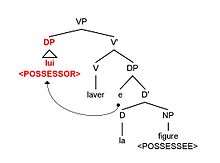
The French data below illustrate how this is thought to work. The possessor lui originates in the specifier of DP as an argument of the noun figure. This is equivalent to an underlying structure Gilles a lavé lui la figure. The possessor raises to the specifier of VP, where it is seen in the surface structure Gilles lui a lavé la figure.
(25) Gilles lui a lavé la figure
Gilles him.DAT washed the face
[TP Gilles [VP luii a lavé [DP ti la figure]]]
'Gilles washed his face'
(Guéron 2007: 611 (100b)) |
According to Guéron, a benefit of this hypothesis is that it is consistent with principles of syntactic movement such as locality of selection and c-command. If the position it needs to move to is already filled, as with a transitive verb like see, the possessor cannot raise, and the sentence is correctly predicted as ungrammatical.[10]
Hebrew
(26) *Gil ra'a le-Rina et ha-punim
Gil saw to Rina the face
[TP Gilj [VP tj ra'a [DP le-Rina et ha panim]]]
NOM *DAT ACC
'Gil saw Rina's face'
(Guéron 2007: 613 (109)) |
However, some languages such as Russian do not have to raise the DP possessor and can leave it in situ, making it unclear why the possessor would ever have to raise.[10] Possessor-raising also violates a constraint on syntactic movement, the specificity constraint: an element cannot be moved out of a DP if that DP is specific.[10] In (23), the DP lui is specific, yet possessor-raising predicts it can be moved out of the larger DP lui la figure. Such movement is excluded by the specificity constraint.
Form function motivations
Inalienable possession constructions often lack overt possessors.[26] There is debate as to how to account for this cross-linguistic universal difference in form. Iconicity explains this in terms of the relationship between the conceptual distance between the possessor and possessee,[31] while economy explains this through frequency of possession.[32]
Iconic motivation (Haiman 1983)
Haiman describes iconic expression and conceptual distance and how two concepts are conceptually close if they share semantic properties, affect each other and cannot be separated from one another.[31] Joseph Greenberg hypothesizes that the distance between the possessor and possessee in a sentence with alienable possession will be greater than it will be in sentences inalienable constructions.[33] Because the possessor and the possessee have a close conceptual relationship, their relative positions with a sentence reflect this and there will not be a lot of distance between them. Increasing the distance between the two would in turn increase their conceptual independence.
This is demonstrated in Hua, a Papuan language. In Hua, alienable possession is marked by a free form pronoun as in (27a). In contrast, inalienable possession constructions use an inalienable possessor prefixed on the possessee, as in (27b). This construction has less linguistic distance between the possessor and possessee than in the alienable construction.
Alienable
(27a) dgai' fu
my pig
'my pig'
Inalienable
(27b) d-za'
my-arm
'my arm'
(Haiman 1983: 793 (30a,b)) |
However, there are cases where linguistic distance does not necessarily reflect conceptual distance. In Mandarin, there are two ways to express the same type of possession, POSSESSOR + POSSESSEE and POSSESSOR + de + POSSESSEE; the latter has more linguistic distance between the possessor and possessee, yet it reflects the same conceptual distance.[34] Both possessive expressions, with and without the marker de, are found in the Mandarin phrase of "my friend", seen in (28a) compared to (28b):[35]
POSSESSOR + de + POSSESSEE
(28a) wǒ DE péngyǒu
I DE friend
'My friend'
POSSESSOR + POSSESSEE
(28b) wǒ péngyǒu
I friend
'My friend'
(Hsu 2009: 101 (22a,b)) |
In contrast to the previous example, omission of the marker de is ungrammatical, as in example (29b). The linguistic distance between the possessor and possessee is much smaller for the example in (29b) than in (29a). It has been argued that omission of de only occurs in kinship relationships, whereas phrasal constructions with a mandatory de encompasses other inalienable possession examples such as body parts.[31]:783 This contradicts the notion that inalienable possession is marked by less linguistic distance between the possessor and possessee.
(29a) wǒ xǐhuān nǐ DE tóufà
I like you DE hair
'I like your hair'
(29b) *wǒ xǐhuān nǐ tóufà
I like you hair
'I like your hair'
(Li & Thompson 1981: 169) |
Economic motivation (Nichols 1988)
Nichols notes that frequently possessed nouns, such as body parts and kinship terms, almost always occur with possessors, whereas alienable nouns occur with possessors less often.[32][36]
The following shows the frequency of possession between alienable and unalienable nouns in German.[36] The table below shows the number of times each noun occurred with or without a possessor in texts from the German Goethe-Corpus, comprising works by Johann Wolfgang von Goethe.
| Noun category | Noun | Unpossessed | Possessed |
|---|---|---|---|
| Alienable | Gärtner 'gardener' Jäger 'hunter' Pfarrer 'priest' | 24 48 12 | 0 2 0 |
| Inalienable | Schwester 'sister' Tante 'aunt' Tochter 'daughter' | 32 47 46 | 58 22 53 |
The alienable nouns above are rarely possessed while the inalienable, kinship terms are frequently possessed.[36] Consequently, inalienable nouns are expected to be possessed, even if they lack a distinct possessive marker. Therefore, overt markings on inalienable nouns are redundant, and in order to employ economical syntactic construction, languages often zero-mark their inalienable nouns.[32] This could be explained by Zipf's Law where the familiarity or frequency of an occurrence motivates the linguistic simplification of the concept.[31] When a listener hears an inalienable noun, they can predict that it will be possessed, thereby eliminating the need for an overt possessor.[26]
Glossary of abbreviations
Morpheme glosses
| * | ungrammatical |
| 3 | third person |
| ACC | accusative case |
| DAT | dative case |
| DEF DAT | definite determiner |
| F | feminine |
| GEN | genitive case |
| NOM | nominative case |
| PL | plural |
| POSS | possessive |
| REFLEX | reflexive |
| SG | singular |
| tx | trace |
| i | co-referenced |
Syntactic trees
| D | determiner |
| DP | determiner phrase |
| N | noun |
| NP | noun phrase |
| PP | prepositional phrase |
| T | tense |
| TP | tense phrase |
| V | verb |
| VP | verb phrase |
| e | empty category |
See also
Notes
- ↑ Cinque and Krapova are citing Lamiroy (2003). "Grammaticalization and external possessor structures in Romance and Germanic languages", p.259, who is in turn citing Leclère (1976). "Datifs syntaxiques et datif éthique."
- ↑ Technically, the obligatory occurrence of a possessor is a property of certain morphemes called obligatory possession, but linguists often use the term inalienable possession to mean this.
- ↑ For example, in the Native American language Diegueño, the alienable possessive marker (?-əny) appears to originate from the inalienable possessive marker (?-ə), suggesting the latter is older.[24]
References
- ↑ Matthews, P. H. "Inalienable possession". The Concise Oxford Dictionary of Linguistics. Oxford University Press. Retrieved 15 September 2014.
- 1 2 3 4 5 Lichtenberk, Frantisek; Vaid, Jyotsna; Chen, Hsin-Chin (2011). "On the interpretation of alienable vs. inalienable possession: A psycholinguistic investigation". Cognitive Linguistics. 22 (4): 659–689. doi:10.1515/cogl.2011.025. Retrieved 29 September 2014.
- 1 2 3 4 Nichols, Johanna; Bickel, Balthasar. "Possessive Classification". World Atlas of Language Structures. Retrieved 2011-02-26.
- ↑ Nichols, Johanna; Bickel, Balthasar. "Feature/Obligatory Possessive Inflection". World Atlas of Language Structures. Retrieved 2011-03-06.
- 1 2 3 4 Heine, Bernd (1997). Cognitive Foundations of Grammar. USA: Oxford University Press. pp. 85–86. ISBN 9780195356205. Retrieved 6 November 2014.
- ↑ Matthews, P. H. "Noun class". The Concise Oxford Dictionary of Linguistics. Oxford University Press. Retrieved 15 November 2014.
- ↑ Cinque, Guglielmo; Krapova, Iliana (2008). "The two "possessor raising" constructions of Bulgarian" (PDF). Working Papers in Linguistics. 18: 68. Retrieved 7 November 2014.
- ↑ Heine, Bernd (1997). Possession: Cognitive Sources, Forces, and Grammaticalization. Cambridge: Cambridge University Press. p. 182.
- 1 2 Krasnoukhova, Olga (2011). "Attributive possession in the languages of South America". Linguistics in the Netherlands. 28 (1): 86–98. doi:10.1075/avt.28.08kra.
- 1 2 3 4 5 6 7 8 9 10 11 Guéron, Jacqueline (2007). "Inalienable Possession". In Everaert, Martin; van Riemsdijk, Henk. The Blackwell Companion to Syntax. Malden, MA: Blackwell Publishing Ltd. pp. 589–638. doi:10.1002/9780470996591. ISBN 9780470996591.
- ↑ Martins, Silvana Andrade (2004). Fonologia e gramática Dâw. Utrecht, Netherlands: LOT. pp. 546–547.
- 1 2 3 Hyman, Larry M.; Alford, Danny; Elizabeth, Akpati (1970). "Inalienable Possession in Igbo". Journal of West African Languages. VII (2).
- ↑ Dol, Philomena (1999). A Grammar of Maybrat: A Language of the Bird's Head, Irian Jaya, Indonesia. University of Leiden. pp. 93–97.
- ↑ Dryer, Matthew S. "Order of Genitive and Noun". The World Atlas of Language Structures Online. Max Planck Institute for Evolutionary Anthropology. Retrieved 29 October 2014.
- ↑ Nichols, Johanna; Bickel, Balthasar. "Obligatory Possessive Inflection". World Atlas of Language Structures. Retrieved 2011-03-06.
- ↑ Valentine, J. Randolph Nishnaabemwin Reference Grammar Nishnaabemwin Reference Grammar. Toronto: University of Toronto Press. 2001. §3.3.1. pg. 106 ff.
- ↑ Nichols, J. D.; Nyholm, E. A Concise Dictionary of Minnesota Ojibwe. Minneapolis: University of Minnesota Press. 1995.
- ↑ Elbert, Samuel H.; Pukui, Mary Kawena (1979). Hawaiian Grammar. Honolulu: University Press of Hawaii. p. 139.
- 1 2 3 Nakamoto, Takeshi (2010). "Inalienable Possession Constructions in French". Lingua. 120 (1): 74–102. doi:10.1016/j.lingua.2009.05.003.
- 1 2 3 4 Vergnaud, Jean-Roger; Zubizarreta, Maria Luisa (1992). "The Definite Determiner and the Inalienable Construction in French and in English". Linguistic Inquiry (Vol. 23, no. 4): 595–652.
- 1 2 Kockelman, Paul (2009). "Inalienable Possession as Grammatical Category and Discourse Pattern". Studies in Language. 33 (1): 29–30. doi:10.1075/sl.33.1.03koc.
- 1 2 Barker, Chris (2011). "Possessives and relational nouns". In Maienborn, Claudia; von Heusinger, Klaus; Portner, Paul. Semantics: An international handbook of natural language meaning (PDF). Berlin: De Gruyter Mouton.
- 1 2 3 4 Stockwell, Robert P.; Schachter, Paul; Partee, Barbara Hall (1973). The Major Syntactic Structures of English. New York: Holt, Rinehart and Winston, Inc. ISBN 0-03-088042-4.
- 1 2 Nichols, Johanna (1992). Linguistic Diversity in Space and Time (ACLS Humanities E-Book ed.). Chicago: University of Chicago Press. pp. 116–123.
- ↑ Herslund, Michael; Baron, Irène (2001). Dimensions of Possession. Amsterdam: John Benjamins Publishing. pp. 1–15. ISBN 9027229511. Retrieved 11 December 2014.
- 1 2 3 Haspelmath, Martin. "Alienable vs. inalienable possessive constructions" (PDF). Max Planck Institute for Evolutionary Anthropology. Leipzig Spring School on Linguistic Diversity. Retrieved 9 November 2014.
- ↑ Matthews, P. H. "Head marking". The Concise Oxford Dictionary of Linguistics. Oxford University Press. Retrieved 15 November 2014.
- 1 2 3 Guéron, Jacqueline. The Blackwell Companion to Syntax, Volume I (Chapter 35). Blackwell Publishing, Ltd. pp. 595–596.
- ↑ Kempchinsky, Paula (1992). "The Spanish possessive dative construction: θ-role assignment and proper government". In Hirschbühler, Paul; Koerner, E.F.K. Linguistic Symposium on Romance Languages (20 ed.). Philadelphia, PA: John Benjamins Publishing Company. pp. 135–148. ISBN 90 272 3591 0.
- ↑ Landau, Idan (1999). "Possessor Raising and the Structure of VP". Lingua. 107 (1): 1–37. doi:10.1016/S0024-3841(98)00025-4.
- 1 2 3 4 Haiman, John (1983). "Iconic and Economic Motivation". Language. 59 (4): 781. doi:10.2307/413373.
- 1 2 3 Nichols, Johanna (1988). "On Alienable and Inalienable Possession". In Honor of Mary Haas. Berlin: Walter de Gruyter & Co. p. 579.
- ↑ Greenberg, Joseph (1966). Universals of Human Language (2nd ed.). Cambridge, MA: MIT Press.
- ↑ Hsu, Yu-Yin (2009). "Possessor extraction in Mandarin Chinese". University of Pennsylvania Working Papers in Linguistics. 15 (1).
- ↑ Li, Charles; Thompson, Sandra (1989). Mandarin Chinese: A Functional Reference Grammar. Berkeley: University of California Press. p. 169.
- 1 2 3 Good, Jeff ed. (2008). Linguistic Universals and Language Change. New York: Oxford University Press. p. 197.
External links
- A map of the world's languages colored by possessive classification complexity from the World Atlas of Language Structures.